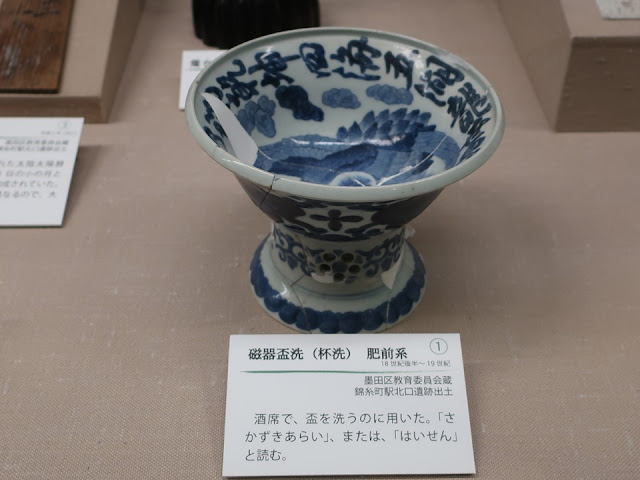The museum is at Mukoujima in Sumida ward, which is near Asakusa in Tokyo. The area beside the Sumida River developed into a resort area after the shogunate was established in Tokyo in 1603. Many people go there even until now to see sakura cherry blossoms in spring. The special exhibition “Sakura at the levee of the Sumida River” was held when I visited last year.
浅草から東へ進んで言問橋を越えたところにある資料館です。向島を中心に墨田区の歴史と文化を紹介しています。
墨田区では、江戸時代以降、隅田川がリゾート地に成長していき、今でも多くの人が行楽を楽しんでいます。一年前ですが、企画展の「隅田川堤の桜」(2022年2月19日~5月15日)を目当てに訪問しました。
The history of Sumida ward is introduced on the 1st floor. A handsome noble in the 9th century “Arihara no Narihira”, who was also an excellent poet, made a well-known poem; it was a feeling to his lover in Kyoto which is far away from Sumida. He asked the local bird whether she was alive or not. I was surprised that were sold to the holidaymakers as souvenirs. I found that ordinary people knew the poem and it has been popular among them since long time ago.
一階では、古代から現代までの墨田区の歴史が紹介されています。
意外だったのは、平安時代の在原業平が詠んだ都鳥、「名にしおはばいざ言問はむ都鳥わが思ふ人はありやなしやと」。後に、隅田川堤のお土産品として売られました。
The toy of the bird is printed on the brochure of the special exhibition.
企画展のリーフレットから「都鳥」を持つ親子。
Sumida ward was almost under the sea in the medieval era.
中世の墨田区域は、ほとんど海でした。
In the Edo period (1603~1868), Sumida developed.
近世になると、ずいぶん華やかになりました。
Mukoujima district was special; daimyo (local lords) had mansions there, in which they lived while they were in Tokyo. (Reference: Sankin-koutai regulation). The photo above is a huge residence of the daimyo of Hirosaki in Aomori. It is city area now, but it was a scenary area back then.
向島は、別荘地域というと言い過ぎですが、農家だけでなく大名の下屋敷(=別荘)がありました。弘前藩(津軽家10万石)は上屋敷を置いていたのですが、豪勢な屋敷です。
The cup above was used to rinse a small cup to drink sake (alcohol). People used one cup, which showed their firm bond.
錦糸町駅北口で発掘された盃洗。盃を洗い返杯するための容器です。一つの盃を使うことで繋がりの強さを確認しました。
Bustle of Sumida levee (Bokutei)、 墨堤のにぎわい
The model above shows the sakura blossoms viewing on the levee in the early 19th century. People enjoyed a boat-ride in summer, the moon viewing in autumn and a snow viewing in winter.
ジオラマコーナーです。春の花見だけでなく、夏の舟遊び、秋の月見、冬の雪見と四季折々の風情を楽しめたそうです。ジオラマでは、明治末期の花見が再現されています。
The boat carries vacationers to Asakusa. People preferred the ferryboat even after the Azuma bridge was built in 1774.
浅草への渡し場も再現されています。吾妻橋が架けられた1774年以降も渡し船が好んで利用されたそうです。
The costume parade of Shichifukujin (Seven Deities of Good Fortune) walks on the levee. There were many factories nearby, the workers performed it. They might be originators of cosplayers at present.
ピントが合ってなくて恐縮なのですが、七福神の格好をした一団もいます。近く工場が多かったので、工員たちが仮装して繰り出したそうです。こういう遊び方をしたのですね。コスプレの元祖でしょうか。
Many intellectuals such as a writer lived there. Mr. Enomoto rode on a horse and went to the levee. He was the general of the shogunate, but worked for the new government after the shogunate had been abolished; he lived there. It's a happy time after retirement.
江戸時代以降、文人たちを惹きつけ、幸田露伴らが住みました。また、戊辰戦争を戦った榎本武揚は、新政府でも大臣を務め、晩年は川の近くに住み、馬で堤を散策したそうです。びっくりしました。豊かな定年後です。
Special exhibition “Sakura at the levee of the Sumida River”、企画展「隅田川堤の桜」
Photography is prohibited in the section above.
The levee was built to block a flood from the Sumida. The sakura trees were planted when the shogun (Yoshimuse) went to Mokuboji (temple) in the 18th century. The trees were continuously planted. It was written that even poets worked with farmers nearby.
Mukoujima district was the place which the shogun to go hawking to. Therefore, it was a nature reserve and preys grew there. It’s good. However, it wasn’t good for farmers because farming was restricted.
Many ukiyoe printings were exhibited. All of them were about the sceneries of the Edo period (1603~1868, feudal era), however half of them were made in the following Meiji period (1868-1912, modern era) when Japan was modernized rapidly. It said that people looked back with nostalgia on the old days, and created picture of the Edo period such as the entertainment of the shogun (former ruler).
All block printings attracted me, but the printing below is excellent. I knew people enjoyed so much at the levee so much. It was Kitagawa Utamaro's art work. Ladies got on the ferry to go to the temporary event of Mimeguri Shrine.
こちらは撮影禁止です。
隅田川堤は、元来は向島を洪水から守るための堤です。八代将軍・吉宗が木母寺(もくぼじ)に御成になったのをきっかけに、その周辺に桜が植えられ南へと延びていき、明治13年(1880年)には、旧水戸藩邸枕橋まで延びる桜並木になりました。俳諧師が村人と協力して植林したとも書かれていました。
向島は将軍家の御鷹場として自然環境が保護され、獲物が育つようにしていました。でも、耕作は規制されお百姓さんにとっては嬉しくないことでした。
企画展にはたくさんの浮世絵が展示されていますが、半数は明治以降のもの。明治半ば過ぎになると、行き過ぎた西洋化を嫌い、江戸城内を描いた「千代田の大奥」など将軍の遊びが描かれたそうです。
どれも桜や船遊びを楽しむ良い絵でした。特に、下の喜多川歌麿の「三囲の土手」は圧倒的でした。浅草との渡し船があった場所で、三囲神社のご開帳に来たご婦人たちが描かれています。土手の向こうに鳥居の頭が見えています。
Mimeguri Shrine at present. 今の三囲神社。三井家が守護神とし、旧三越池袋店にあったライオン像が境内に移設されています。
Visited in May, 2022
Official website: https://www.city.sumida.lg.jp/sisetu_info/siryou/kyoudobunka/
(in Japanese), accessed in March, 2023
Previous post (museum in Tokyo): Toyo Bunko、東洋文庫
Next post (museum at the sakura viewing spot in Tokyo): Kita City Asukayama Museum、北区飛鳥山博物館














Comments
Post a Comment